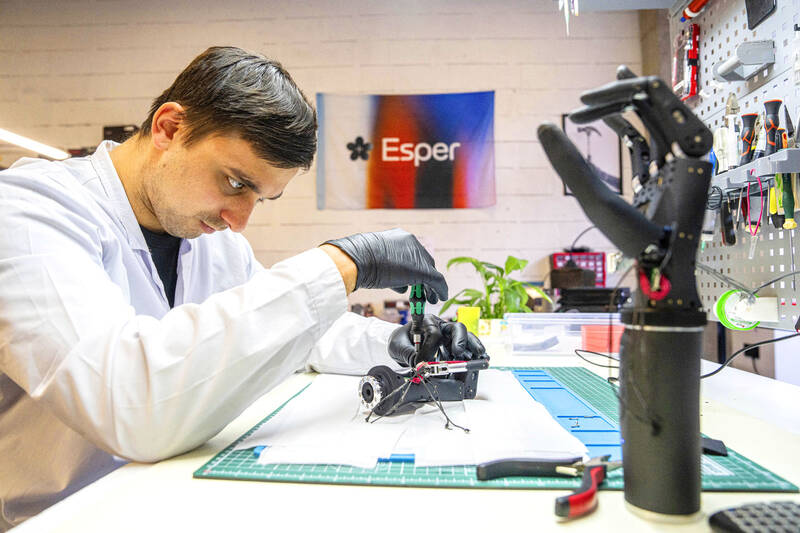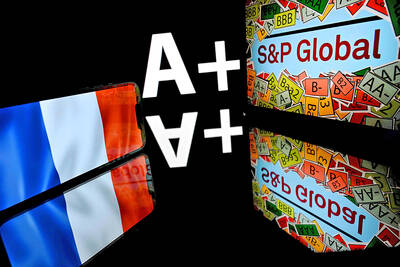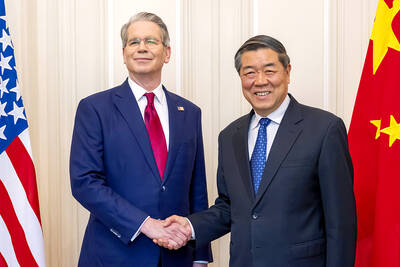When Alexis Cholas lost his right arm as a volunteer combat medic near the front lines in eastern Ukraine, his civilian career as a surgeon was over. Thanks to a new bionic arm, he was able to continue working in healthcare and is now a rehab specialist helping other amputees.
The 26-year-old is delighted with his sleek black robotic arm — he described it as “love at first sight” — and realizes how lucky he was to get one.
“There are fewer [bionic] arms available than lost ones,” Cholas said.

Photo: AP
Russia’s invasion of Ukraine has created a massive need for prosthetic limbs. An estimated 20,000 Ukrainians have had amputations since the war started in February last year, many of them soldiers who lost arms or legs due to blast wounds.
Only a small number was able to receive bionic prostheses, which are more advanced and can provide greater mobility than the traditional prosthetic limbs.
They are also far more costly than conventional prostheses.
Bionic artificial limbs typically pick up electrical signals from the muscles that remain above the amputation site, thanks to something called myoelectric technology, to carry out an intended motion.
Cholas’ bionic arm was made by Esper Bionics. Before last year, the Ukrainian start-up primarily targeted the US market, but due to the sharp rise in demand for prosthetic limbs caused by the war, Esper now distributes 70 percent of its products at home.
The company’s production hub in the capital, Kyiv, is working at full capacity, with more than 30 workers producing about dozen bionic hands a month.
In one corner of the factory, a small group of engineers huddle as they program, assemble and test the elegant bionic arms — known as Esper Hand. Each finger’s movement on the robotic hand is accompanied by a soft whirring sound, assuring the engineers of its smooth operation.
Bohdan Diorditsa, head of strategic relations at the company, said that despite ramping up production, Esper Bionics is struggling to keep up with demand, with almost 120 people on the waitlist.
In Ukraine, the company said it provides the bionic prostheses at zero profit for about US$7,000 a piece, just enough to cover production costs.
In the US, the Esper Hand sells for more than US$20,000.
“We do not consider Ukraine as a market, but rather as an opportunity to help,” Diorditsa said.
Compared to a conventional prosthesis, which is designed to replicate simple basic functions of a missing arm or leg, a bionic one offers the capability to restore fine motor skills.
“Everyone wants them,” said Anton Haidash, a prosthetist at Unbroken, a municipal center in Lviv that focuses on rehabilitation of civilians and soldiers affected by the war.
The center has helped provide prosthetic limbs to about 250 people so far, including about 20 bionic arms.
The difference in cost is significant. While bionic limbs can cost up to US$50,000, conventional artificial limbs are priced at US$800 to US$2,700, Haidash said.
Ukrainians can get the regular artificial limbs free of charge through the public health care system. To get a bionic prosthesis, they normally need additional funding from charities or rehabilitation centers such as Unbroken, which depend on donations.
While patients can make the final decision about the type of prostheses they want, a variety of factors, including the nature of the injury and the person’s occupation, also play a role.
Unbroken purchases bionic prostheses from German and Icelandic companies as well as Esper Bionics, whose notable advantage is having a manufacturing and a service center in Ukraine. This means people do not need to travel abroad when a repair or resizing is required.
Another outstanding characteristic of the Esper Hand, which is powered by artificial intelligence (AI), is its ability to adapt over time, learning the user’s unique interactions with the hand.
After getting outfitted with his bionic arm, Cholas went back to volunteering as a combat medic on the front lines, while in his day job in Kyiv he works as a rehabilitation specialist in a public hospital. Most of his patients are members of the military or civilians who, like him, have lost limbs.
He said that their shared experience helps him quickly develop a rapport with his patients.
“I now know a lot not only from textbooks, but also from my own experience,” he said.
Cholas speaks to his patients encouragingly as he examines their injuries. His movements with the bionic hand are natural and fluid. He effortlessly removes a bandage and dresses a patient’s wounds without the assistance of nurses.
The bionic prosthesis allows him to perform even delicate movements, such as picking up a grape without crushing it, he said.
“I feel uncomfortable when I’m without the prosthesis,” he said. “But when I have the bionic arm on, I feel comfortable. It’s like a part of you.”

Jensen Huang (黃仁勳), founder and CEO of US-based artificial intelligence chip designer Nvidia Corp and Taiwan Semiconductor Manufacturing Co (TSMC, 台積電) on Friday celebrated the first Nvidia Blackwell wafer produced on US soil. Huang visited TSMC’s advanced wafer fab in the US state of Arizona and joined the Taiwanese chipmaker’s executives to witness the efforts to “build the infrastructure that powers the world’s AI factories, right here in America,” Nvidia said in a statement. At the event, Huang joined Y.L. Wang (王英郎), vice president of operations at TSMC, in signing their names on the Blackwell wafer to

France cannot afford to ignore the third credit-rating reduction in less than a year, French Minister of Finance Roland Lescure said. “Three agencies have downgraded us and we can’t ignore this cloud,” he told Franceinfo on Saturday, speaking just hours after S&P lowered his country’s credit rating to “A+” from “AA-” in an unscheduled move. “Fundamentally, it’s an additional cloud to a weather forecast that was already pretty gray. It’s a call for lucidity and responsibility,” he said, adding that this is “a call to be serious.” The credit assessor’s move means France has lost its double-A rating at two of the

AI BOOST: Although Taiwan’s reliance on Chinese rare earth elements is limited, it could face indirect impacts from supply issues and price volatility, an economist said DBS Bank Ltd (星展銀行) has sharply raised its forecast for Taiwan’s economic growth this year to 5.6 percent, citing stronger-than-expected exports and investment linked to artificial intelligence (AI), as it said that the current momentum could peak soon. The acceleration of the global AI race has fueled a surge in Taiwan’s AI-related capital spending and exports of information and communications technology (ICT) products, which have been key drivers of growth this year. “We have revised our GDP forecast for Taiwan upward to 5.6 percent from 4 percent, an upgrade that mainly reflects stronger-than-expected AI-related exports and investment in the third

RARE EARTHS: The call between the US Treasury Secretary and his Chinese counterpart came as Washington sought to rally G7 partners in response to China’s export controls China and the US on Saturday agreed to conduct another round of trade negotiations in the coming week, as the world’s two biggest economies seek to avoid another damaging tit-for-tat tariff battle. Beijing last week announced sweeping controls on the critical rare earths industry, prompting US President Donald Trump to threaten 100 percent tariffs on imports from China in retaliation. Trump had also threatened to cancel his expected meeting with Chinese President Xi Jinping (習近平) in South Korea later this month on the sidelines of the APEC summit. In the latest indication of efforts to resolve their dispute, Chinese state media reported that